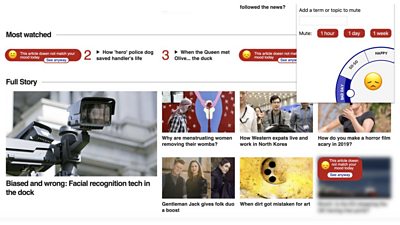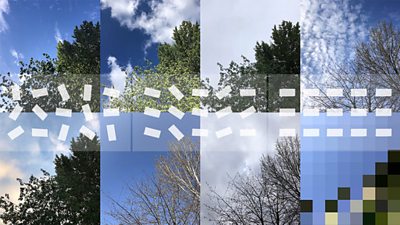We are working on a series of short exploratory sprints to understand where we can best make an impact to improve our audience’s wellbeing online, and the wellbeing of society in general. Our first two-week sprint was led by Alicia, on a topic she's been working on in her 10% time - news and mental health for young people. In this post we set out the process we used and our conclusions about whether a 'mute' button for news is a useful tool.

Alicia: "The mood filter is a simple Web Extension using vanilla Javascript with some jQuery. The simplicity of creating a web extension makes it the perfect tool for quick prototyping. It allows you to modify, add or delete elements of any web page displayed in the browser. To do so, it uses its own set of APIs which enable it to interact with the browser tabs, bookmarks, clipboard, cookies and other features. Web extensions are very easy to share with other people, even non-technical team members installed it without any difficulties."
Since it is a web extension it can’t be used with mobile phones, and it only works on the ���˿��� News homepage, so this is not the typical way that young people would consume the news. However, we felt that we could learn about attitudes to muting items from the news by testing this format, so it was still worthwhile to do a user test.
User test
The aims of the test were to:
- Gather feedback on the prototype, to see if people understood how to use it, and to facilitate a deeper conversation about why they might use it
- Find out more about young adults’ needs, behaviour and attitude towards news and their general consumption of it. Are people actively avoiding news? Do news headlines affect mental health and general well being?
Our hypothesis was:
Because we think that young people avoid the news because it is depressing and makes them feel helpless, we think that giving them more control over what’s visible to them will mean that they are more likely to read the news.
Results
We did a guerilla test in London with seven subjects 18-24 years old: three female, four male; three students, and four other members of the public.
All participants followed the news, and no participant was filtered out because they did not. Two used news apps, two said they got their news from social media, and two talked about news websites; the ���˿��� News site was mentioned by one of these two.
Their frequency of checking the news ranged between once a day and twice a week, but some news they just come across without looking for it. One person mentioned “Social media and other stuff that just pops up”.
Six of the seven found the news made them feel “not positive” or “sad”.
Four participants said variations on “staying informed” when asked why they looked at the news; two were interested in specific topics, and one mentioned both:
“Mostly politics, to keep up with what is related to my community, and follow important stories like Brexit and Trump” .
Three understood from their first impression what the extension would do, though all expected it to remove or reshuffle the content, not keep it in place. Two thought it was good that the story was left in place; one thought that the blurring just drew attention to it. Two would improve the app by removing the muted articles or putting them in a different place.
All those who entered a word used one that was already visible on the page; one participant said they would
“Mute terms related to the stories which are negative opinions without any facts”
When prompted, four of the seven thought timed muting would improve the application, for example, limiting the muting to one day or one week.
Three thought muting was a risky or dangerous feature and that certain words should not be muted. An example quote:
“News isn't meant to be tailored to you. We shouldn't be sheltered from it. If I don't want to read an article I will look at the title and decide. I can imagine [the extension] being used more out of hatred and to fuel discrimination, e.g. people filtering out stories about refugees”.
One would use the prototype; three wouldn’t; one thought it might be useful for vulnerable people.
Conclusions and recommendations
Going back to our hypothesis:
Because we think that young people avoid the news because it is depressing and makes them feel helpless, we think that giving them more control over what’s visible to them will mean that they are more likely to read the news.
Our desk and user research backs up our assumption that young people avoid the news because they find it depressing. However, either keyword-muting is not the right mechanism of control or we are not using the right metrics to measure success (i.e. the metrics of looking at news often and for longer). Our qualitative, limited user research suggests that allowing muting by keyword on a news homepage ������’t the right way to get young people to look at the news more often and for longer.

Our recommendations are:
- Consider allowing people to restrict or specify their notifications in the news app
- Promote positive news stories via social media and particularly in onward journeys
- Identify positive news stories more visibly and enable people to find them
- Consider testing mute and blur with news-phobic people and / or people with poor mental health
- Consider testing temporary muting of keywords
- Consider testing the classification of degrees of distress caused by stories and allowing people to blur or de-emphasise / relocate distressing stories
More detail is below.
What are the right mechanisms of control?
A problem with the test that we identified early on was that most news for this age-group will either come from a news app or via a link in social media, not a news homepage.
If someone’s main access point for news is an app, then our research suggests the ability to mute certain notification topics will improve wellbeing. Giving people the opportunity to do this could improve use of the app (notifications work positively for this), but avoid the contextless triggering of negative emotions.
If the main access route is social media, our research suggests that promoting positive news stories via social media and linking to positive stories from a story might increase the amount of time people stay on the site. Positive news stories already exist on ���˿��� News online, but are not necessarily identifiable at a glance.
It is possible that the extension's mute-and-blur mechanism might be a good way to give people with poor mental health more control over their news environment, but to know this we would need to design it around their specific needs and test it with vulnerable people, with appropriate professional support.
We could also test with news-phobic people rather than people who keep up with the news regularly.
We could also test other ways of de-emphasising the more upsetting stories. This could be done by removing images, making headlines smaller and positioning them lower down in the stream.
Alternatively, to avoid negative uses of keyword-based muting, i.e. instances of “it being used more out of hatred and to fuel discrimination”, we could return to one of the alternative hackday concepts - grading news according to how upsetting the content is, and then allowing people to choose how they feel today - perhaps as an extrapolation of the content warnings used by TV news.
Our informal experiments judging the negativity of a story suggest that the whole concept is slippery and imprecise, and might simply be too subjective a concept to be useful. One variant that could be done much more easily is to clearly identify positive news stories, and allow people to find them more easily.

What are the right metrics?
All of the people we spoke to regularly looked at the news. Much of the news is distressing, and it’s understandable that people do not want to spend lots of time on a news site. Young people are cutting back on their number of visits and time spent on news sites for this reason, which seems like a positive outcome for mental health. Perhaps regular visits are a better metric than time spent or frequency of visits?
Next steps
Below is a screenshot of the extension after Alicia updated it following the feedback from the user test, showing an example of mood-based, time-limited filtering, and here is a final word from Alicia:
"Working on this project has made me question my own relationship with news, especially online news. Without being news-phobic, I noticed that I was avoiding news altogether on days that I was in a challenging mood. Working on the web extension, I had to browse the ���˿��� News homepage everyday, without having the possibility to avoid it when I wanted. I noticed that the fact that I was interacting with it and that I wasn’t only a passive user made me enjoy engaging with it more and more and bit by bit it begin to feel less apprehensive towards it. This experience really made me think there is a very interesting correlation to explore here about how people feel more concerned and appreciate consuming a webpage if they are able to manipulate it and adapt it to their own needs and sensibilities. This whole idea of “giving power back to people” is a theme that I intend to explore more in future projects whenever possible."

[1] 'The psychological impact of negative TV news bulletins: The catastrophizing of personal worries' from the British journal of psychology, M. Johnston, Wendy & Davey, Graham. (1997)
[2] (Boczkowski et al, 2017)
- -
- ���˿��� R&D - Journalism
- ���˿��� R&D - Beyond 800 Words: Prototyping New Story Formats for News
- ���˿��� R&D - Building a Public Service Internet
- ���˿��� R&D - Newsbeat Explains - Piecing Together the News for Young Audiences
- ���˿��� R&D - Mobile-First News for Young People - Our Findings from Newsbeat Explains
- ���˿��� News Labs - 2018 in Review
- ���˿��� News Labs - 2017 in Review
-

Internet Research and Future Services section
The Internet Research and Future Services section is an interdisciplinary team of researchers, technologists, designers, and data scientists who carry out original research to solve problems for the ���˿���. Our work focuses on the intersection of audience needs and public service values, with digital media and machine learning. We develop research insights, prototypes and systems using experimental approaches and emerging technologies.
Topics
Search by Tag:
- Tagged with Blog Blog
- Tagged with Journalism Journalism
- Tagged with User Interfaces User Interfaces
- Tagged with Mobile Mobile
- Tagged with Social Social
- Tagged with Content Discovery Content Discovery
- Tagged with Personalisation Personalisation
- Tagged with Internet Research and Future Services Internet Research and Future Services
- Tagged with Reinventing the News Article Reinventing the News Article

